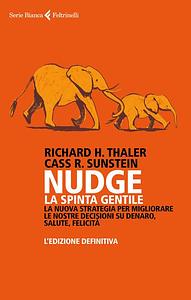Take a photo of a barcode or cover
While there is nothing earth shaking in the themes presented in this book, the authors put together a very good (and quick) narrative on the ideas of choice architecture. I suspect most people look at choice architecture as consumers, but to me this is a very good reminder of important concepts as an engineer.
Interesting read, but written more for policymakers and design architects than gen pop.
informative
slow-paced
a coworker recommended and let me borrow this so i pushed through but man just disagreed w a lot here and thought it missed a lot of the social reasons for some of these issues. it's also pretty outdated at this point so that's probably a big reason why it wasn't as enjoyable or informative for me.
This book was full of thought- and discussion-provoking examples and ideas. Buy MY LORD was it boring. Especially the chapters on 401k's and mortgages. This proves the authors' point in that the average person does not want to read through all of the available information on those topics -and I certainly didn't feel like reading it in this book.
I wholeheartedly disagree with some of their hypotheses (charter schools, for example). The most salient point for me is that there is no such thing as no nudge or default. Even inaction IS an action and a choice. I would definitely recommend this book for any policy maker.
I wholeheartedly disagree with some of their hypotheses (charter schools, for example). The most salient point for me is that there is no such thing as no nudge or default. Even inaction IS an action and a choice. I would definitely recommend this book for any policy maker.
informative
reflective
medium-paced
I read this as part of a book club at work--they were reading it, and I figured it was something I should read at some point. I think the ideas have filtered into the public consciousness enough by now that I didn't feel like I learned much new (so I guess I was wrong to think I should read it at some point). The idea of a "nudge"--altering the presentation of options in a choice situation so as to encourage desired behavior, while preserving the fundamental underlying right to choose (not imposing too much cost)--is a good one, but I think the authors oversell its value. There are a couple of very valuable policy ideas, such as opt-out enrollment for retirement plans, but the well starts to run dry pretty quickly, and soon the authors are talking about putting fly stickers in urinals. A worthy tool for a policymaker's kit, but not more than that. Unfortunately, I also think that the scope for private sector companies to uses nudges to enrich themselves is much greater than the scope for government to use nudges for the common good. I don't blame the authors for that, of course.
essential reading for anyone interested in research, or policy research (one alternative -- do a PhD program and read the original literature).
I applied some of these approaches to advocacy projects, and found them relevant and lots of fun. One or two chapters are a bit off, but that does not change that this is an excellent book that expands your perspective.
I applied some of these approaches to advocacy projects, and found them relevant and lots of fun. One or two chapters are a bit off, but that does not change that this is an excellent book that expands your perspective.
This book:regular econ books::festivus:christmas*.
*And I'm not talking gifts-to-the-ceiling-and-ham-for-everyone modern western Christmas; I mean Little-House-on-the-Prairie, you-get-an-orange-and-a-walnut-and-then-sit-around-and-think-about-Jesus Christmas.
*And I'm not talking gifts-to-the-ceiling-and-ham-for-everyone modern western Christmas; I mean Little-House-on-the-Prairie, you-get-an-orange-and-a-walnut-and-then-sit-around-and-think-about-Jesus Christmas.


